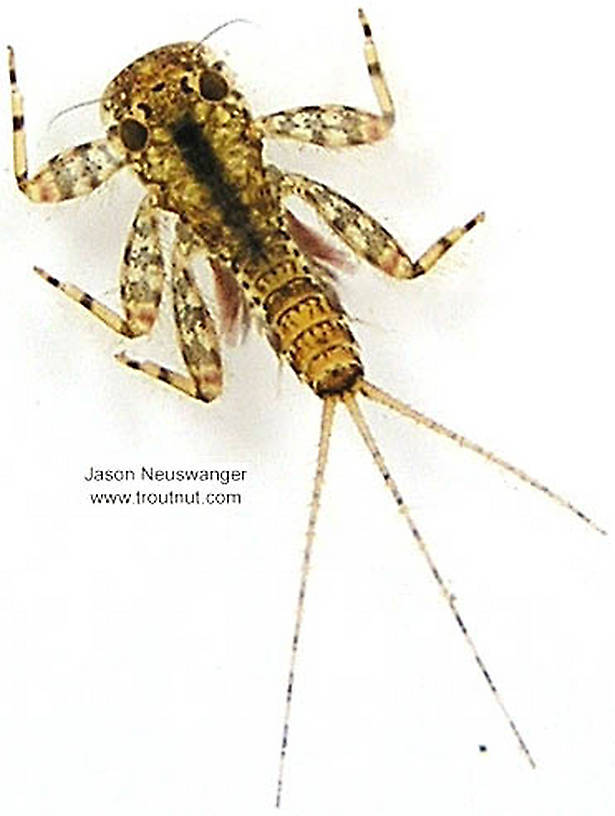
Blue-winged Olives
Baetis
Tiny Baetis mayflies are perhaps the most commonly encountered and imitated by anglers on all American trout streams due to their great abundance, widespread distribution, and trout-friendly emergence habits.

Mayfly Species Stenonema luteum
Species Range
Physical description
Most physical descriptions on Troutnut are direct or slightly edited quotes from the original scientific sources describing or updating the species, although there may be errors in copying them to this website. Such descriptions aren't always definitive, because species often turn out to be more variable than the original describers observed. In some cases, only a single specimen was described! However, they are useful starting points.
Male Spinner
Wing length: 10.5 mm
Eyes pale green, in living insect. Head pale yellowish white anterior to ocelli; carina with faint oblique reddish streak; antennse narrowly red-ringed at base; Vertex yellowish to yellow-brown near ocelli; reddish brown oblique streaks posteriorly; a red-brown spot may be present behind median ocellus, and a narrow line at margin of eye. Pronotum and mesonotum very pale ochreous; scutellum broadly creamy white; pleura yellowish white; an area between fore and middle legs and a portion of mesosternum tinged with light brown. Anterior portion of metanotum creamy; light brown posteriorly, this area appearing as a dark basal band on the pale abdomen. Coxae streaked with smoky on anterior and posterior margins; a faint pinkish patch behind posterior black streak. Legs pale amber. Fore femur with smoky tinge; median and apical purplish red bands on all femora. Tip of fore tibia, claw and tarsal joinings smoky. Basal fore tarsal joint rather short, slightly less than 5 the length of second. Wings hyaline; stigmatic area of fore wing light amber with slight reddish tinges. Costa, subcosta and radius dark smoky amber; other veins blackish; cross veins well developed.
Abdominal segments 1-7 hyaline, whitish yellow; dorsal posterior margins of tergites crossed by narrow black lines. No spiracular dots. Segments 8-10 opaque, creamy white; tergites 8 and 9, sometimes anterior portion of 10, shaded with pink. Forceps pale; genitalia of the Stenonema pulchellum type. Tails pale, joinings smoky.
This species is distinguishable from allied forms by reason of its large size, pale coloration and lack of spiracular dots.
Specimens of the Mayfly Species Stenonema luteum
1 Nymph
Start a Discussion of Stenonema luteum
References
- Leonard, Justin W. and Fannie A. Leonard. 1962. Mayflies of Michigan Trout Streams. Cranbrook Institute of Science.
- Needham, James G., Jay R. Traver, and Yin-Chi Hsu. 1935. The Biology of Mayflies. Comstock Publishing Company, Inc.
Mayfly Species Stenonema luteum
Species Range
Resources
- NatureServe
- Integrated Taxonomic Information System
- Global Biodiversity Information Facility
- Described by Clemens (1913)



